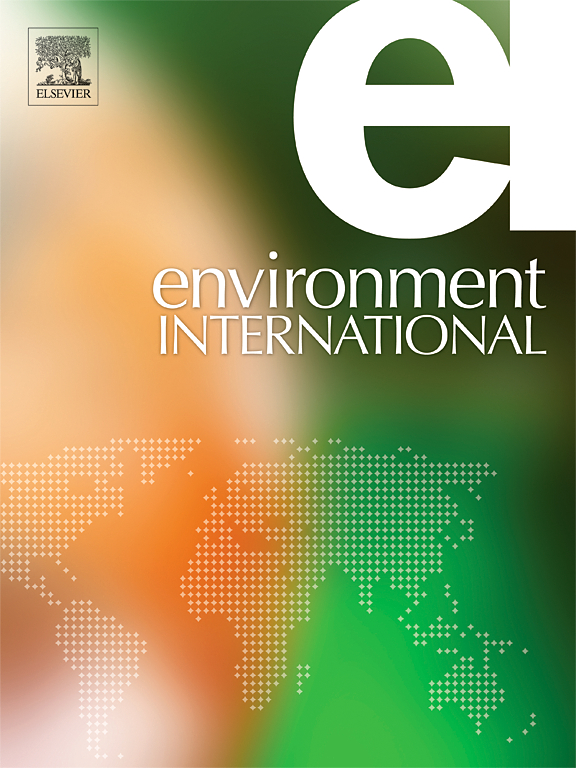城市地区植物物种丰富度、绿地与早产风险
IF 10.3
1区 环境科学与生态学
Q1 ENVIRONMENTAL SCIENCES
引用次数: 0
摘要
越来越多的证据表明,城市生物多样性可能影响人类健康,尽管这种关系仍不完全清楚。虽然绿地已显示出对出生结果的有益影响,但植物物种丰富度与早产(PTB,妊娠37 周)的具体作用尚未得到调查。方法使用Kaiser Permanente南加州电子健康记录(2015-2021),分析了232,452例新生儿,以研究植物物种丰富度与PTB之间的关系。植物物种丰富度在母系邻里水平进行评估,以母系居住地周围1.5 km的圆形缓冲带定义。结果植物物种丰富度的增加与PTB风险的降低相关(校正四分位数比值比:0.959,95 % CI: 0.941, 0.977)。在进一步调整多个绿地指标后,观察到的关联仍然存在。各植物物种多样性指标中,平均妊娠期温度的中介效应比例为7.0 % ~ 7.8 %。在亚组分析中,植物物种多样性表明,在暴露于较高水平臭氧、较高环境温度的母亲和在大流行期间分娩的母亲中,对PTB的保护作用明显更强。相反,在怀孕期间二氧化氮暴露较低的母亲中,保护性关联更为明显。值得注意的是,在调整了妊娠期COVID-19感染后,在流行期分析中,植物物种丰富度与PTB减少之间的显著关系仍然存在。结论我们的研究结果强调了影响肺结核风险的社会人口和环境因素的复杂相互作用,并强调了考虑城市绿地独特属性的公共卫生干预措施的迫切需要。本文章由计算机程序翻译,如有差异,请以英文原文为准。
Plant species richness, green spaces, and preterm birth risk in urban areas
Background
Growing evidence suggests that urban biodiversity may influence human health, though this relationship remains incompletely understood. While green spaces have shown beneficial effects on birth outcomes, the specific role of plant species richness has not been investigated in relation to preterm birth (PTB, <37 weeks’ gestation).
Methods
Using Kaiser Permanente Southern California electronic health records (2015–2021), we analyzed 232,452 births to examine associations between plant species richness and PTB. Plant species richness was assessed at the maternal neighborhood level, defined using circular buffers of 1.5 km around maternal residences.
Results
We found that increased plant species richness was associated with decreased PTB risk (adjusted odds ratio per interquartile range: 0.959, 95 % CI: 0.941, 0.977). The observed association persisted after further adjustment for multiple green space indicators. The proportions of mediation effects attributable to mean temperature during pregnancy ranged from 7.0 % to 7.8 % across plant species diversity indicators. In the subgroup analysis, plant species diversity demonstrated significantly stronger protective associations against PTB among mothers exposed to higher levels of Ozone, high ambient temperatures, and those gave birth during the pandemic period. Conversely, protective associations were more pronounced among mothers with lower NO2 exposure during pregnancy. Notably, the significant relationship between plant species richness and reduced PTB persisted in pandemic-period analyses after adjusting for COVID-19 infection during pregnancy.
Conclusions
Our findings highlight a complex interplay of sociodemographic and environmental factors influencing PTB risks and underscore the critical need for public health interventions that consider the unique attributes of urban green space.
求助全文
通过发布文献求助,成功后即可免费获取论文全文。
去求助
来源期刊

Environment International
环境科学-环境科学
CiteScore
21.90
自引率
3.40%
发文量
734
审稿时长
2.8 months
期刊介绍:
Environmental Health publishes manuscripts focusing on critical aspects of environmental and occupational medicine, including studies in toxicology and epidemiology, to illuminate the human health implications of exposure to environmental hazards. The journal adopts an open-access model and practices open peer review.
It caters to scientists and practitioners across all environmental science domains, directly or indirectly impacting human health and well-being. With a commitment to enhancing the prevention of environmentally-related health risks, Environmental Health serves as a public health journal for the community and scientists engaged in matters of public health significance concerning the environment.
 求助内容:
求助内容: 应助结果提醒方式:
应助结果提醒方式:


